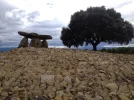Well done
@C clearly for taking on this immense task! I think the Romanesque thread has shown that there is a real appetite for this and that we can all learn more, share resources etc in a really constructive way.
A few points:
- Neatly fitting pretty much anything into categories is tricky at best. Remember how each of us is one of only four categories of pilgrim?

That said, architecture probably lends itself to categorisation more than most other things although it might still be delicate at times.
- On that point, the listed categories are not as perfectly 'linear' as they seem in the case of Spain. I'm taken back to something
@peregrina2000 wrote in the Romanesque thread about time and space, given that different styles of architecture were being produced at the same time when the peninsula was divided into parts ruled by Christians and parts ruled by Muslims. For example, the Burgos cathedral and the main parts of the Alhambra both date from around the same time but are not the same type of architecture.
- Regarding Muslim architecture and presence on the peninsula as a whole, we are throwing a few words around here (Moorish, Mozárabe, Mudéjar) and some clarification might be worthwhile. Moors (
moros ESP,
mouros POR) are what the Muslims who invaded the peninsula in 711 were called. Mozárabes were Christians living under Moorish rule in the southern part of the peninsula. Mudéjar refers to Muslim influence on Christian lands after they had been reconquered. How does this relate back to architecture? Let's consider three buildings: the Mezquita in Córdoba ('Moorish'), the church in Wamba (often described as Visigothic-Mozárabe - again, hard to be neat here), and San Tirso in Sahagún (Mudéjar with some Romanesque). I would suggest that they are wildly different from each other. So we need to think this through a bit.
- The other era that stands out as a bit tricky to me is the period between classical Rome (and let's use the Segovia aqueduct as our example here) and Romanesque (say, San Martín in Frómista). This is nearly 1,000 years' worth of architecture. Various terms such as Visigothic and pre-Romanesque have been used upthread but don't capture the entirety of the period (I tend to define pre-Romanesque as not simply 'something that came before Romanesque' but more 'something that you can see will develop into Romanesque soon'). I would suggest 'early Christian' or similar for this period, and this can cover a series of styles for which there are not many extant examples: late Roman or perhaps Paleo-Christian, as these terms overlap (e.g. Santa Eulalia de Bóveda on/near the Primitivo), Visigothic (e.g. São Frutuoso in Braga), Mozárabe (e.g. Wamba, again) and pre-Romanesque (e.g. the Naranco churches near Oviedo). Admittedly, Visigothic and Mozárabe are hard to distinguish and you can often see both in the same building.
- I would certainly separate prehistoric and Roman. I also see these as wildly different, although you do have some examples of castros where you have a pre-Roman settlement that was taken over by Romans.
- Within Gothic, you can have sub-categories, such as Manueline architecture which can be seen in Belém (near Lisbon) and Tomar on the CP, among other places.

















